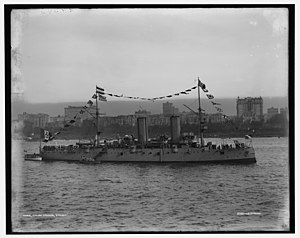Italian cruiser Elba

Elba's sister ship Etruria in 1909
|
|
| History | |
|---|---|
|
|
|
| Name: | Elba |
| Namesake: | Island of Elba |
| Laid down: | 22 September 1890 |
| Launched: | 12 August 1893 |
| Commissioned: | 27 February 1896 |
| Fate: | Sold for scrap, 5 January 1920 |
| General characteristics | |
| Class and type: | Regioni-class cruiser |
| Displacement: | 3,110 t (3,060 long tons; 3,430 short tons) |
| Length: | 88.2 m (289 ft) |
| Beam: | 12.72 m (41.7 ft) |
| Draft: | 4.86 m (15.9 ft) |
| Installed power: | 4 water-tube boilers, 7,471 ihp (5,571 kW) |
| Propulsion: | 2 shaft triple-expansion engines |
| Speed: | 17.9 knots (33.2 km/h; 20.6 mph) |
| Range: | 2,100 nmi (3,900 km; 2,400 mi) at 10 knots (19 km/h; 12 mph) |
| Complement: | 213–278 |
| Armament: |
|
| Armor: |
|
Elba was a protected cruiser of the Italian Regia Marina (Royal Navy). She was the fifth of six Regioni-class ships, all of which were named for regions of Italy, with the exception of Elba, which was named for the island. Elba was built by the Regio Cantieri di Castellammare di Stabia; her keel was laid in September 1890, she was launched in August 1893, and she was commissioned in February 1896. The ship was equipped with a main armament of four 15 cm (5.9 in) and six 12 cm (4.7 in) guns, and she could steam at a speed of nearly 18 knots (33 km/h; 21 mph).
Elba spent much of her career abroad. She participated in the blockade of Venezuela during the Venezuelan crisis of 1902–03 and was present in East Asia during the Russo-Japanese War in 1904–05. In February 1904, her crew witnessed the Battle of Chemulpo Bay between Japanese and Russian warships; after the battle ended in Russian defeat, Elba and British and French cruisers picked up survivors. She took part in the Italo-Turkish War in 1911–12 but saw no action, being used primarily to blockade Turkish ports in the Red Sea. In 1914, Elba was converted into the first seaplane tender of the Regia Marina, with equipment to handle three seaplanes. This service did not last long, however, as she was too small and too old. Decommissioned by 1916, the old warship was sold for scrap in January 1920 and broken up.
Elba was slightly larger than her sister ships. She was 88.2 meters (289 ft) long overall and had a beam of 12.72 m (41.7 ft) and a draft of 4.86 m (15.9 ft). She displaced up to 3,110 metric tons (3,060 long tons; 3,430 short tons) at full load. Her propulsion system consisted of a pair of horizontal triple-expansion engines, with steam supplied by four cylindrical water-tube boilers. On her speed trials, she reached a maximum of 17.9 knots (33.2 km/h; 20.6 mph) at 7,471 indicated horsepower (5,571 kW). The ship had a cruising radius of about 2,100 nautical miles (3,900 km; 2,400 mi) at a speed of 10 knots (19 km/h; 12 mph). She had a crew of between 213–278. Also unlike her sisters, she had a copper-sheathed hull, which reduced fouling during lengthy periods between dockyard maintenance.
...
Wikipedia
